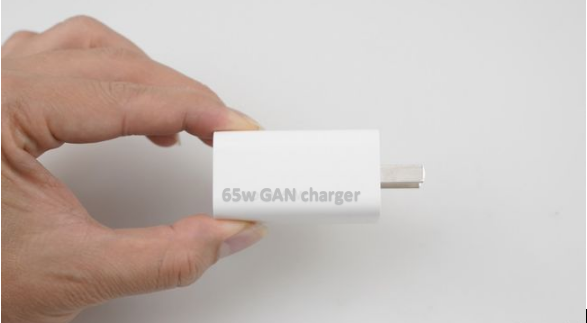I believe that friends who are concerned about the mobile phone industry have noticed that "Gallium Nitride (GaN)" has appeared more frequently recently. Especially after Xiaomi released its first 65W gallium nitride fast charging charger, the term "gallium nitride" began to appear in the public's field of vision. So, what is the difference between a charger that introduces "GaN" and a traditional ordinary charger? Let’s talk today.
- 1.What is GaN?
- 2.Different materials are the root of all differences:
- 3.Why is gallium nitride better than silicon?
- 4.Since gallium nitride is so good? Why not use it earlier?

1.What is GaN?
Before discussing GaN chargers, let me first explain GaN. GaN stands for gallium nitride, which is a glass-like semiconductor material. Similar to silicon and other semiconductors, silicon nitride can also conduct electricity, but it is faster and more energy efficient.
GaN materials have been in use since the 1990s, but they have never become mainstream. It is widely used in lasers, LEDs and blue light to make disc reading possible. Now, GaN technology is being applied to chargers, and the best part is that it makes the charging bricks of our smartphones and laptops smaller.
This is not only the only advantage, but it can also reduce heat dissipation, thereby improving energy efficiency. In short, GaN chargers are much smaller in size than traditional chargers, and are faster and more energy efficient than silicon materials.
2.Different materials are the root of all differences:
The basic material of a traditional ordinary charger is silicon, which is also a very important material in the electronics industry. However, as the limits of silicon are gradually approaching, the development of silicon has reached a certain bottleneck, and many manufacturers have begun to work hard to find more suitable substitutes.
In addition, with the increase of the fast charging power, the fast charging head is larger, and it is very inconvenient to carry; some high-power chargers can easily cause the charging hair to heat for a long time; therefore, it is more urgent to find new alternative materials .

Gallium nitride (GaN) is called the third-generation semiconductor material. Compared with silicon, its performance is doubled, and it is more suitable for high-power devices than silicon, with smaller volume and greater power density. The frequency of gallium nitride chips is much higher than that of silicon, which effectively reduces the volume of internal transformers and other components. At the same time, the excellent heat dissipation performance also enables the layout of internal components to be more precise, which finally perfectly solves the contradiction between charging rate and portability. Obviously, gallium nitride is the alternative material we are looking for.

Knowing the characteristics of their respective materials, the difference between a gallium nitride charger and an ordinary charger is self-evident. The gallium nitride charger is smaller in size with the same power, and has better heat dissipation, which makes it easy to achieve small size and high power.
3.Why Is Gallium Nitride Superior to Silicon?
Now coming to the technicality as to why Gallium Nitride is superior to Silicon. If you have read a fair bit of Physics, you would know that semiconductors have something called a bandgap. The smaller the bandgap, the better is the flow of electricity from one band to another. For comparison, Silicon has a 1.12 eV bandgap and Gallium Nitride has a 3.4 eV bandgap.
From the figure, it seems that Silicon is a better medium to conduct electricity than GaN. However, the issue here is the loss of energy due to such a small bandgap in Silicon. If the bandgap is too low then photons get too much energy which leads to waste of energy, hence more heat dissipation in silicon-based materials.
Gallium Nitride maintains a healthy bandgap of 3.4eV which ensures more voltage is sustained and the electrons pass through the bands without any loss of energy. It means there is faster processing of charges which leads to better charging speed and efficient flow of energy.
Also, GaN material can survive at higher temperatures much better than Silicon. And due to this less-heat mechanism, GaN chargers don’t require additional components like a heatsink and filter circuit elements which reduce the size of the brick considerably.
To sum it up, GaN chargers are better than Silicon ones in terms of footprint, charging speed, and energy efficiency.
4.Since gallium nitride is so good? Why not use it earlier?
The reason is simple: GaN technology was not mature before, and the cost was relatively higher! The main cost of gallium nitride chargers comes from MOS power chips. Expensive raw materials have directly led to the high price of consumer-grade GaN chargers. At present, there are basically more than one hundred gallium nitride chargers on the market. However, as more and more manufacturers participate, it is believed that the technology will become more and more mature, and the cost reduction is only a matter of time.
In terms of the charging protocol, the GaN charging head currently uses the PD protocol as the mainstay, and can quickly charge devices that support this protocol, including MacBook (and other C-mount notebooks), iPad Pro, iPhone, Switch and other devices. With the blessing of gallium nitride, it is believed that the fast charging power of smart phones is expected to reach new highs.

As users’ demand for charger versatility and portability increases, the GaN fast charging market will grow rapidly in the future. According to data from CITIC Securities, the global GaN charger market is expected to reach 2.3 billion yuan in 2020, and it will rapidly rise to 63.8 billion yuan, with a five-year compound annual growth rate of 94%.
In terms of the entire consumer electronics industry, GaN has already received attention and investment in mainstream consumer electronics manufacturers around the world, and GaN is also rapidly exploding with chargers. In terms of overall performance and cost, GaN is also expected to become the mainstream choice for fast charging devices in the consumer electronics field in the future.


